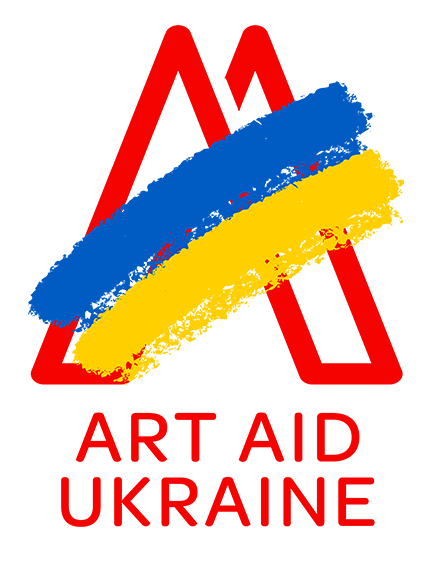Cassandra
Ola Rondiak
Cassandra was inspired by Ukrainian National poet Lesia Ukrainka's retelling of the Trojan War and the siege of Troy as seen through the eyes of Cassandra, who was cursed to see the future but not to be believed.
Ola Rondiak’s paintings stem from her family’s experiences living in Ukraine during the historical events of WWII, Stalin’s Iron Curtain, the Orange Revolution in 2004 and the Revolution of Dignity in 2014. These events shaped Ola Rondiak’s world view. Emotional experiences surface in her artworks as her own history intertwines with Ukrainian history and tradition, preparing the viewer with a rare "contemporary art with a historical conscious." As stated by Kathrine Page (Delaware Contemporary Museum), Rondiak “harvests a bold new, deeply personal prototype emblematic of feminine tenacity stitched in truth through the thread of her own story. Rondiak’s creativity cuts the cloth of a new absolute beauty with a redemptive quality that clearly understands the important healing role of art and the psyche for future generations.” The female image looms large, and for Ola Rondiak, the female portrait underpins the terrain for truth and dignity on her canvases and installations. "Her large ultra-flat paintings derived from Byzantine medieval mural painting offer a local shared symbology imbued with historical reference, made contemporary by the use of Post-Modernist techniques." (Juan Puntes, Whitebox, NYC)
Rondiak’s work is part of a permanent collection of The Revolution of Dignity Museum in Kyiv, Ukraine, The Ukrainian Embassy in Bern Switzerland, Shevchenko Museum & National Museum of Decorative Arts in Kaniv, Ukraine, Ukrainian Embassy in Paris, Hudson River Museum in New York and private collectors. Rondiak’s landmark painted mural in the historic district of Kyiv, Ukraine, is a prominent part of Kyiv’s Street Art explosion.
Regarding this series, Ola says “My grandmother's story greatly influences my work...” On March 28th, 1947, Ola's Grandmother Paraskevia was arrested by the Soviet NKVD, charged with “Assisting the Ukrainian Partisan Army” and sentenced by military tribunal to 25 years of hard labor at the Women’s Strict Regime Prison in Mordovia, Russia. There was no trial, no court, and no judge.
While in prison, at great personal risk, Paraskevia began embroidering religious icons at night, by the light of the northern latitudes. She used cloth and threads from her clothes and fish bones for needles.
The geometric sewing patterns which underline the form of these emotive portraits were inspired by thoughts of her grandmother secretly at work creating embroidered icons, considered illegal in the harsh Soviet gulag.
Ola Rondiak’s paintings stem from her family’s experiences living in Ukraine during the historical events of WWII, Stalin’s Iron Curtain, the Orange Revolution in 2004 and the Revolution of Dignity in 2014. These events shaped Ola Rondiak’s world view. Emotional experiences surface in her artworks as her own history intertwines with Ukrainian history and tradition, preparing the viewer with a rare "contemporary art with a historical conscious." As stated by Kathrine Page (Delaware Contemporary Museum), Rondiak “harvests a bold new, deeply personal prototype emblematic of feminine tenacity stitched in truth through the thread of her own story. Rondiak’s creativity cuts the cloth of a new absolute beauty with a redemptive quality that clearly understands the important healing role of art and the psyche for future generations.” The female image looms large, and for Ola Rondiak, the female portrait underpins the terrain for truth and dignity on her canvases and installations. "Her large ultra-flat paintings derived from Byzantine medieval mural painting offer a local shared symbology imbued with historical reference, made contemporary by the use of Post-Modernist techniques." (Juan Puntes, Whitebox, NYC)
Rondiak’s work is part of a permanent collection of The Revolution of Dignity Museum in Kyiv, Ukraine, The Ukrainian Embassy in Bern Switzerland, Shevchenko Museum & National Museum of Decorative Arts in Kaniv, Ukraine, Ukrainian Embassy in Paris, Hudson River Museum in New York and private collectors. Rondiak’s landmark painted mural in the historic district of Kyiv, Ukraine, is a prominent part of Kyiv’s Street Art explosion.
Regarding this series, Ola says “My grandmother's story greatly influences my work...” On March 28th, 1947, Ola's Grandmother Paraskevia was arrested by the Soviet NKVD, charged with “Assisting the Ukrainian Partisan Army” and sentenced by military tribunal to 25 years of hard labor at the Women’s Strict Regime Prison in Mordovia, Russia. There was no trial, no court, and no judge.
While in prison, at great personal risk, Paraskevia began embroidering religious icons at night, by the light of the northern latitudes. She used cloth and threads from her clothes and fish bones for needles.
The geometric sewing patterns which underline the form of these emotive portraits were inspired by thoughts of her grandmother secretly at work creating embroidered icons, considered illegal in the harsh Soviet gulag.
